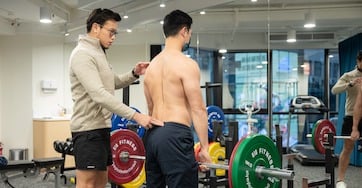Swimmers can have shoulder pains for many reasons. Younger swimmers commonly develop shoulder injuries because they aren’t strong enough to always do the strokes correctly. For more mature swimmers, poor technique is the primary factor for a shoulder injury.
Swimmers shoulder can bring lots of pain to an individual as they lose the mobility of one of the most major joint systems in the body. So it’s essential to identify how you can do your best to implement the correct swim technique to reduce your risk of injury.
What is swimmers shoulder?
Swimmers shoulder is a condition where swimmers often cause distress to their shoulders while they swim due to the constant joint rotation. If you’re a competitive swimmer — or just enthusiastic — it’s likely you’ve had or will have suffered pain in your shoulder.
The shoulder joint is one of the most complicated joints in the body because it can move in so many directions. Due to the heavy use of shoulders in swimming techniques, the most prevalent injury in swimming is to do with the shoulder.
Causes of swimmers shoulders
Reasons for swimmers shoulders can vary. As we’ve mentioned before, as a young swimmer, you can develop pain by not being strong enough to perform the stroke. However, young swimmers are pliable in making the appropriate changes to their stroke, so it’s easier for them. Over time, young swimmers then get stronger and less susceptible to injury.
Mature swimmers tend to suffer an injury due to improper technique, but other factors can also contribute, such as:
- Poor workstation posture
- Throwing your child in the pool and pulling your shoulder
- Doing intense physical activity (like playing basketball), then going back into advanced swim practice on Monday
- Lack of/inadequate warm-up
All of these situations can lead to changes in your swim stroke, making swim stroke the primary cause of swimmer’s shoulder. Unfortunately, with the extra movement in the shoulder joint, it can be unstable and at more risk for injury.
With swimmers, we commonly see two different forms of shoulder impingement (or tendonitis) caused at various times during the stroke:
Shoulder impingement 1
The first type of impingement occurs during the pull-through phase of freestyle. The pull-through phase begins when the hand enters the water and ends when the arm has completed pulling through the water (and begins to exit the water).
At the beginning of pull-through, if a swimmer’s hand enters the water across the midline of the body, this can place too much internal rotation in the shoulder which impinges the long head of the biceps against the shoulder joint.
Unilateral breathing may also contribute to swimmer’s shoulder. Swimmers who consistently turn their heads to the same side to breathe during the stroke are risking shoulder pain in the opposite shoulder. This is because there is a decreased movement in tilting and rotating the trunk to the non-breathing side.
Shoulder impingement 2
The second type of impingement may occur during the recovery phase of freestyle. This phase is the time of the stroke cycle when the arm is exiting the water and lasts until the hand enters the water again.
This requires a body roll, raising the elbow up and out of the water to allow the arm to recover.
As a swimmer starts to fatigue, it will become more difficult for them to lift their arm out the water. The muscles of the rotator cuff externally rotate and depress the head of the humerus against the shoulder joint become less efficient. When these muscles are not working correctly, the supraspinatus muscle (one of the rotator cuff muscles) will be impinged between the humerus and shoulder joint — causing the non-breathing side to work harder to support forward movement and increasing the chances of shoulder impingement.
Equipment causes
Besides the two common sets of causes, improper use of training equipment can contribute to shoulder pain. These are circumstances such as:
- The use of hand paddles that are much larger than a swimmers hand (or paddles with no drainage holes) can place great strain on the shoulder muscles during the pull-through in freestyle.
- The use of hand paddles when a swimmer is fatigues (or when the posterior shoulder is not strong enough to balance). This can result in tendonitis of the shoulder.
- Using a kickboard with arms fully extended in front of a swimmer can place shoulders in a position of impingement.
- The use of fins to keep up/act as a crutch is not good for proper shoulder stroke and strength development.
The longer a swimmer uses these items or misuses them, the greater the risk of shoulder pains for them. However, there are times in training to use all the equipment mentioned above, but it should be appropriately handled and never as a means to allow you to go faster.
How to prevent shoulder pains
If you’ve experienced shoulder pains and it has prevented you from training, you know how frustrating this can be. The first thing you need to look at is your stroke. Correcting your stroke technique is not that difficult, but you need to know what you’re looking for and then work hard to improve those areas. Here are a few ways to improve your stroke by stretching and straightening, see if you can incorporate some of these exercises to your current training program.
4 ways to improve your stroke and reduce injury risk
1. Hold a streamline position out of the water
Get your arms behind your head, hold your arms straight and tight against your head and squeeze those shoulder blades (a workout if appropriately performed). This is a great exercise to stretch the anterior shoulder and strengthen the posterior shoulder and scapular stabilisers.
2. Strengthen the external rotators of the shoulder.
These muscles are inherently weak but are responsible for stabilising the shoulder joint. Weak external rotators are often the cause of shoulder impingement.
3. Stretch your anterior shoulders regularly but not forcefully.
The doorway stretch is an excellent stretch for the anterior shoulder but should be performed gradually and held for 30 to 60 seconds. We recommend one arm at a time at two positions, 90 degrees and 110 degrees.
4. Strengthen your posterior deltoids to create a neutral shoulder.
Swimmers often have tight pectorals and anterior deltoids. Strengthening the posterior deltoid promotes a stabilised shoulder — decreasing your risk of impingement.
Our Advice
Swimming is a great form of physical exercise, especially in the summer. By following the above mentioned prevention techniques, you should be able to minimise your chances of future injury. Most importantly remember to stretch and don’t strain yourself!
If you’ve been suffering from swimmers shoulders, or know that you’re prone to injury, consult an OT&P Physiotherapist for more specific advice about your condition.

 Central General Practice
Central General Practice
 Repulse Bay
Repulse Bay
 Clearwater Bay
Clearwater Bay
 BodyWorX Clinic
BodyWorX Clinic
 Central Specialist Clinic
Central Specialist Clinic
 MindWorX Clinic
MindWorX Clinic
 Partner Clinics
Partner Clinics
 Family Clinic
Family Clinic
 OT&P Annerley Midwives Clinic
OT&P Annerley Midwives Clinic


